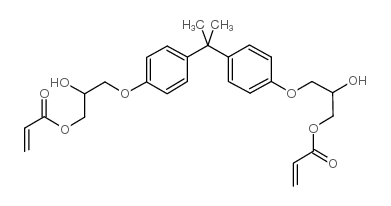双酚A甘油二丙烯酸

双酚A甘油二丙烯酸结构式

|
常用名 | 双酚A甘油二丙烯酸 | 英文名 | (1-methylethylidene)bis[4,1-phenyleneoxy(2-hydroxy-3,1-propanediyl)] diacrylate |
|---|---|---|---|---|
| CAS号 | 4687-94-9 | 分子量 | 484.53800 | |
| 密度 | 1.18 g/mL at 25ºC(lit.) | 沸点 | 654.1ºC at 760 mmHg | |
| 分子式 | C27H32O8 | 熔点 | N/A | |
| MSDS | 美版 | 闪点 | >230 °F | |
| 符号 |

GHS07 |
信号词 | Warning |
|
Allergic contact dermatitis due to an epoxy acrylate.
Br. J. Dermatol. 104(6) , 697-703, (1981) A printer developed allergic contact dermatitis due to epoxy acrylate resin. Incomplete cross-reactivity between four epoxy acrylate resins and a lack of cross-reactivity to epoxy resin was demonstrated. The epoxy acrylate resin has been shown to be a potent ... |
|
|
The performance of specialized collections of bisphenol A epoxy resin system components in the evaluation of workers in an occupational health clinic population.
Contact Dermatitis 28(4) , 216-9, (1993) Epoxy resin of the bisphenol A type (ERBA) is a common cause of occupational contact dermatitis. 167 patients with a history of potential exposure were patch tested with epoxy resin (molecular weight 340) (ERBAM) 1% in pet. and with a number of other ingredie... |
|
|
The sensitizing potential of di-(meth)acrylates based on bisphenol A or epoxy resin in the guinea pig.
Contact Dermatitis 10(5) , 286-304, (1984) Most composite materials in dentistry used today, contain resins based on dimethacrylates. BIS-GMA [2,2-bis-(4-(2-hydroxy-3-methacryloxypropoxy)phenyl)propane], the addition reaction product of bisphenol A and glycidyl methacrylate or an epoxy resin and metha... |
|
|
Sensitization capacity of acrylated prepolymers in ultraviolet curing inks tested in the guinea pig.
Acta Derm. Venereol. 61(1) , 7-10, (1981) One commonly used prepolymer in ultraviolet (UV) curing inks is epoxy acrylate. Of 6 men with dermatitis contracted from UV-curing inks, 2 had positive patch test reaction to epoxy acrylate. None reacted to the chemically related bisphenol A dimethacrylate. T... |
|
|
Occupational dermatoses in workers exposed to epoxy-impregnated fiberglass fabric.
Derm. Beruf Umwelt. 37(5) , 171-6, (1989) In December, 1985, and February, 1986, skin diseases were investigated among workers in a plant producing printed circuit boards made of copper sheets and fiberglass fabric impregnated with a brominated epoxy resin. A questionnaire was sent to all 159 employe... |
|
|
Cross-reactivity among epoxy acrylates and bisphenol F epoxy resins in patients with bisphenol A epoxy resin sensitivity.
Am. J. Contact Dermatitis 13(3) , 108-15, (2002) The study's objective was 2-fold: first, to evaluate the potential cross-reactivity between Bis-A epoxy resins and epoxy acrylates and second, to study the cross reactivity between Bis-A epoxy resins and newer Bis-F epoxy resins in patients with allergic cont... |
|
|
Occupational allergic contact dermatitis caused by epoxy diacrylate in ultraviolet-light-cured paint, and bisphenol A in dental composite resin.
Contact Dermatitis 33(2) , 94-9, (1995) Allergic contact dermatitis (ACD) caused by epoxy di(meth)acrylates or bisphenol A is rare. Here 2 such cases are reported. A dental assistant had allergic contact dermatitis (ACD) caused by bisphenol A contained in dental composite resin (DCR) products based... |
|
|
Occupational dermatitis due to an epoxy acrylate.
Contact Dermatitis 14(2) , 80-4, (1986) A dental assistant developed sensitivity to dental restorative materials within 3 months of starting to use them. They contained the epoxy acrylate BIS-GMA, which is the most commonly used dimethacrylate monomer in dental composite restorations. She was posit... |
|
|
Wet air oxidation of epoxy acrylate monomer industrial wastewater.
J. Hazard. Mater. 178(1-3) , 786-91, (2010) Epoxy acrylate monomer industrial wastewater contained highly concentrated and toxic organic compounds. The wet air oxidation (WAO) and catalytic wet air oxidation (CWAO) were used to eliminate pollutants in order to examine the feasibility of the WAO/CWAO as... |
|
|
A new soft lithographic route for the facile fabrication of hydrophilic sandwich microchips.
Electrophoresis 33(16) , 2591-7, (2012) Manufacturing materials are an essential element for the fabrication of microfluidic chips. PDMS, the most widely used polymeric material, is associated with apparent disadvantages such as hydrophobic nature, while other materials also suffer from some limita... |